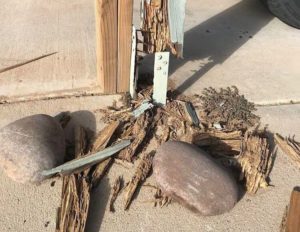The main staple of the termite diet is cellulose, and cellulose can come in many forms, from books and clothing material, to floors, furniture and ceilings. When the damage caused by termites is excessive, the material will start to look like it is water damaged. For ceilings, you may also notice sagging and buckling, and at this point, the repairs can cost thousands of dollars.
What does termite ceiling damage look like?
There are several signs that will become visible once you have termite ceiling damage. To start, you may notice that the ceiling begins to crack as the termites infest the structural timbers and the wood starts shifting from the damage. Drywood termites will also have to evacuate their waste out of the wood, so you may start to notice frass that looks like ridged, brown pellets under the infested wood. Finally, you may notice the presence of winged termites inside the home. If the winged termites had no way of getting indoors, and there are quite a few of them, they may come from a colony that is inside the home.
Preventing ceiling damage
The best way to make sure that your ceilings don’t get too damaged is to have regular termite inspections performed by a professional. A pest control pro can detect an infestation early on, which means that treatment and repairs will be a lot less expensive. A regular inspection on a yearly basis should do the job.
Control
There are a few options when it comes to controlling an infestation that has occurred in the ceiling. If you are familiar with DIY home repair projects, you can try to tackle the infestation yourself using termite treatment products found commercially. In this case, the treatment will consist of spraying or injecting insecticides into the infested wood. Depending on the product, the procedure may require digging holes into the wood, and applying the treatment several times.
However, the procedure can be complicated and it’s essential that you remove an infestation in its entirety, otherwise, the termites will simply reinfest the wood, or infest another part of the home. You also have to make sure that an infestation is restricted to a certain area. If the infestation is widespread, you will need to go with a fumigation treatment.
If you would like to find out more information about controlling termite infestations that have occurred in the ceiling, or if you need some help in removing an infestation, contact us today.
